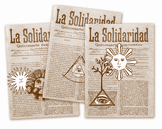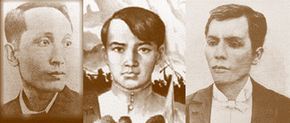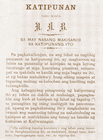
Diwang Filipino
In Search of the Essence of the Filipino Mason
In Search of the Essence of the Filipino Mason
Nicolas G. Ricafrente
|
With the speed by which information travels today via the internet, the politics and territorial disputes which seem to challenge the fraternity today have become subjects of various electronic Masonic forums. The issues may sound disturbing as they merely confound public perception of Masonry, but they also underscore the fact that the organization, the physical body of Masonry, like the magnificent temple of Solomon is not immune to the vicissitudes of time. But the real Temple that is Masonry has survived through the ages, and will survive as long as the "attentive ear receives the sound of the instructive tongue, and the mysteries of Masonry are safely deposited in the repository of faithful breasts". Unity in diversity
Perhaps it is time to realize that universality of Masonic tenets notwithstanding, it is Man, his nature and his culture that govern how these tenets are practiced and propagated. The philosophical body of Speculative Masonry, which started to evolve during the Age of Enlightenment in Europe, wisely left us lessons illustrated in symbols and veiled in allegory, so that men of future ages may not cease to search, reaffirm, or discover useful truths and build their spiritual temples worthy for that eternal house not made with hands.
The histories of the fraternity of Masons in different countries are as varied as there are different races and cultures. Therefore, consciously or subliminally, cultural idiosyncrasies, people’s aspirations, sense of values, deep-rooted beliefs and traditions are assimilated into each stream of philosophical thoughts and the Mason’s personal formation. Masonry then, is unity in diversity; Masons are the same yet, different. A study of Filipino literature, including the writings of some of our celebrated Masonic brothers, gives us insights into our traditions, customs, beliefs, virtues and values. These are considered as intangible parts of our culture; the parts that evolve an ideology—a system of beliefs that transforms a people into a nation. Accepting the dynamic nature of culture then, and in so far that we are constantly exposed to external influences, what have we preserved and what have we lost? What traditions, values or virtues have been diluted, warped or forgotten? How does the present generation value our historical and cultural heritage? What is the present definition of national pride? Since the inception of the Independent Grand Lodge of the Philippine Islands (IGLPI,) questions regarding the culture of the Filipino and the Filipino Mason have been raised. We raise these questions again and in a modest way, invite others to try and sort out some answers if only to start self examination that may eventually lead to a Masonic renewal. In the Kartilya of the Katipunan, Emilio Jacinto deals with the universal theme of the value of time: "Huag mong sasayangin ang panahun; ang yamang nawala’y magyayaring bumalik; ngunit panahong nagdaan na’y di na muli pang magdadaan" "Don’t ever waste time; lost wealth may be retrieved but time that has passed will never pass again." To waste time is to squander opportunities, and the Kartilya also tells us that a lifetime spent without a great and virtuous purpose is a tree without a shade if not a poisonous weed. (“ Ang kabuhayang hindi ginugugol sa isang malaki at banal na kadahilanan ay kahoy na walang lilim, kundi damong makamandag”). Here, Jacinto might have been referring to apathy, complacency, ignorance or laziness that are corollary to wasting time; that apart from being in a state of useless existence (walang lilim), such condition could also poison (damong makamandag) others by example. On the other hand, while time is irreversible, there is always the possibility that things that were lost may still be recovered. And, in this light that perhaps, we should reflect on our lost wealth (“yamang nawala”) in terms of values, virtues and heritage, to enable us to search and recover them. We owe it to those who conceived of true Philippine Masonry, while searching for unity and identity, to determine the true essence of this brotherhood and emulate the ideals they valiantly stood for. Diwang Filipino
Diwang Filipino is the spirit, the soul and consciousness of the Filipino. Our patriots and heroes worked hard for these; searching ways for the Indio to realize his potential; to be proud of his heritage; to understand his plight; to assert his birthright, and to promote national consciousness that would create a distinct, proud and united race, Their search found fruition in the Indios becoming the true Filipinos - Filipinos who found their self respect and later fought and gave their lives for nothing less than total freedom.
The history of Masonry in the Philippines dates back from 1856 when the first Portuguese lodge was founded in Cavite. Soon the colony became a sort of a melting pot of Lodges from Spanish and other European Grand Orient Lodges, but the Indios were generally barred from them; only “Filipinos” who were defined as insulares (Spaniards born in the Philippines), creoles and mestizos were accepted. Yet, many of these 19th century “Filipinos” had rightfully earned their places in our history by being Filipinos by heart and joining the Indios in their struggles. Moreover, the organization of the first truly Filipino Lodge in 1892 would not have been possible without their help. The history of Masonry in the country, and the roots of true Philippine Masonry deserve more than a recitation of facts and events. We may never be able to re-live the past but we may recover those which were lost. When we do, we can reaffirm the values that once forged our people in unity and the spirit that made us free. Philippine Masonry should not be allowed to become a tree without a shade. If there is a person more challenged by the clarion call for Moral Regeneration, perhaps it is the Filipino Mason. [Read more] |
Moral Code for Filipinos
Apolinario Mabini issued the "True Decalogue" a ten point code of moral conduct which served as a preface to the constitutional program he submitted to Gen Aguinaldo in 1898 and later to the Malolos Congress. Prior to this, at the start of active recruitment for the separatist Katipunan, Emilio Jacinto, wrote "Ang Kartilya ng Katipunan", a primer for members with a similar code that expounded on the duties and responsibilities of every recruit, if he were to become part of the movement and later of the Filipino nation. It was Andres Bonifacio however who wrote the first decalogue but reportedly, when he saw Jacinto's work, he deemed it better than his own and subsequently had it printed for official use.
Emilio Jacinto
Unlike Mabini (Logia Balagtas) and Bonifacio (Logia Taliba), Jacinto was not a Mason. He was only 19 years old during the heightened surveillance of Masons in 1894 which stifled Masonic activities. In the same year he stopped schooling and joined the Katipunan. The philosophy and ideology he espoused in his Kartilya were perhaps greatly influenced by his uncle, Jose Dizon who took care of him when his father died. Dizon founded Logia Taliba in 1892, became Grand Fourth Vice-president of the Gran Consejo Regional of the Grande Oriente Espanol in 1893, and was one of the founders of the Katipunan. A true patriot, Emilio Jacinto also fought during the Philippine-American War and died of malaria in the hills of Majayjay on April 16, 1899.
The Katipunan Code of Conduct
|